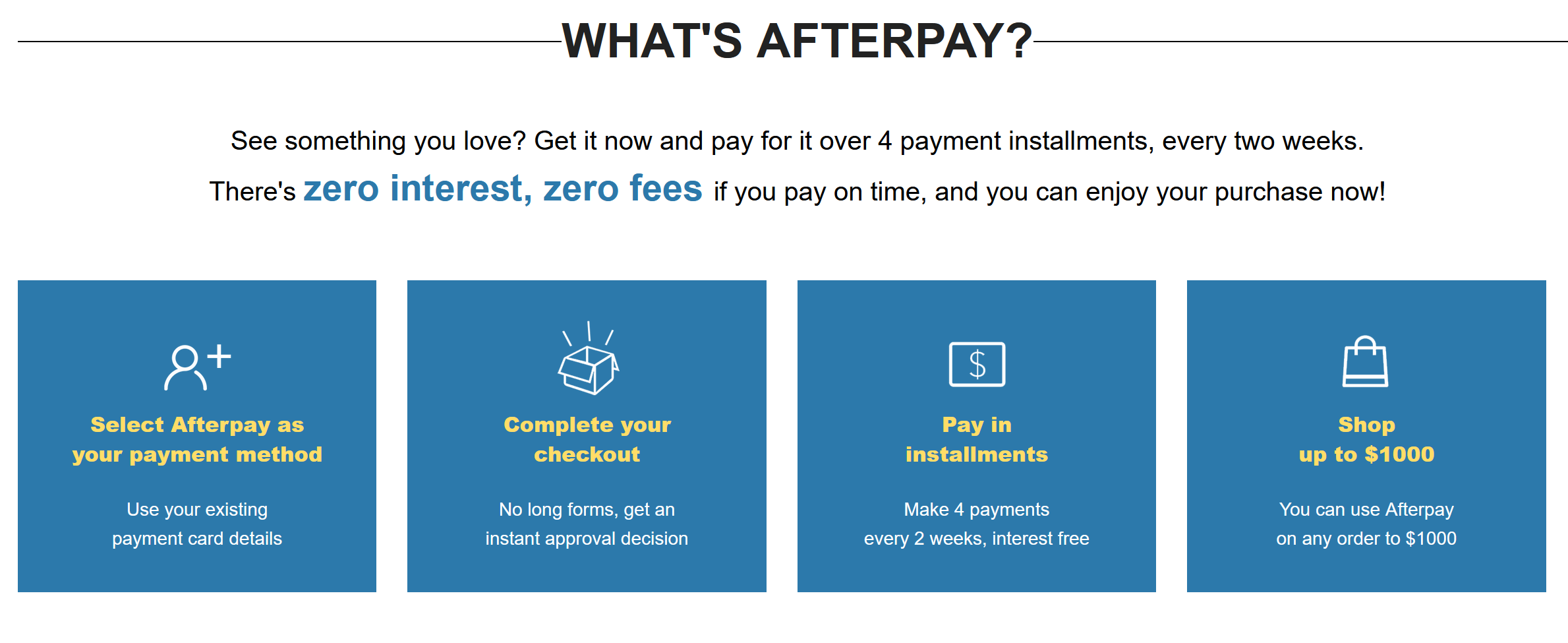What is Buy Now, Pay Later?
Buy Now, Pay Later or BNPL is any option for a customer to make a “purchase” and take possession of goods while agreeing to terms to pay at a future date, typically with several payments staggered across a specific time period. There are companies that offer BNPL options and facilitate the process for businesses. Afterpay is one such company.What is Afterpay?
Afterpay (now called Cash App Afterpay) is a Buy Now, Pay Later platform that allows your customers to make purchases online or in-store and pay for them in 4 installments or more. If the customer pays according to the terms, the installments are interest-free, making them an attractive option for customers. Typically, the payments are spread out over 6 weeks for the main "pay in 4" option, but there are also monthly repayment plans spread across 6-12 months. Afterpay is widely accepted by retailers in a variety of industries, including home goods, electronics, fashion, and more. It’s particularly appealing in industries with high average transaction amounts, as it makes the total purchase price seem more palatable to customers. As a BNPL platform, Afterpay offers instant approval to customers and does not require a “hard” credit check, which is helpful for customers with limited credit history. The company also boasts no hidden fees. As long as customers pay on time according to the terms, there is no interest. (There is a late fee if customers miss a payment.)How Afterpay Works for Consumers
From a consumer’s perspective, the process is straightforward. When the consumer shops with a business that offers Afterpay, they can select it as their payment option at checkout. Above is an example of Afterpay as a choice from a range of payment options on an ecommerce site. It dynamically displays the amount of the installment payment based on the total of the items in my cart. (Note that some businesses may have a minimum purchase amount to be eligible for Afterpay or other BNPL purchases.)
Clicking the ? next to the Afterpay option brings up a page that explains more about the BNPL option.
Above is an example of Afterpay as a choice from a range of payment options on an ecommerce site. It dynamically displays the amount of the installment payment based on the total of the items in my cart. (Note that some businesses may have a minimum purchase amount to be eligible for Afterpay or other BNPL purchases.)
Clicking the ? next to the Afterpay option brings up a page that explains more about the BNPL option.
 If the consumer chooses the Afterpay option, Afterpay will perform an eligibility check by doing a “soft pull” of the consumer’s credit. This does not impact the consumer’s credit score. If approved, the consumer proceeds to checkout, where they can either opt for “pay in 4” or a monthly repayment over 6-12 months. With “pay in 4,” their total bill gets split into 4 equal payments. The first is due at the time of purchase and the subsequent 3 payments are due every 2 weeks. Monthly installments vary by purchase.
Afterpay will require a payment method (typically a credit or debit card) that it will automatically charge on the due dates. However, customers can manage their payments and dates in the Afterpay app.
If the customer misses a payment, Afterpay charges a late fee (usually between $5-$10) and attempts to charge the payment method again.
If the consumer chooses the Afterpay option, Afterpay will perform an eligibility check by doing a “soft pull” of the consumer’s credit. This does not impact the consumer’s credit score. If approved, the consumer proceeds to checkout, where they can either opt for “pay in 4” or a monthly repayment over 6-12 months. With “pay in 4,” their total bill gets split into 4 equal payments. The first is due at the time of purchase and the subsequent 3 payments are due every 2 weeks. Monthly installments vary by purchase.
Afterpay will require a payment method (typically a credit or debit card) that it will automatically charge on the due dates. However, customers can manage their payments and dates in the Afterpay app.
If the customer misses a payment, Afterpay charges a late fee (usually between $5-$10) and attempts to charge the payment method again.




